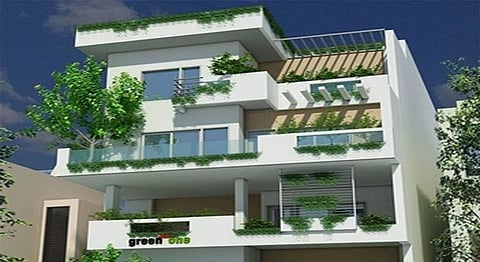
- HOMEGROWN WORLD
- #HGCREATORS
- #HGEXPLORE
- #HGVOICES
- #HGSHOP
- CAREERS
- ABOUT US
- CONTACT US

India’s first certified green home, located in South Delhi’s Chittaranjan Park, is a testament to living green, three years down the line. It exemplifies the fact that building with a green conscience is not more expensive. In fact, if one looks to the near future, it is an irrefutably cheaper alternative to construct an environmentally friendly home.
Green One, the aptly named abode of Prasanto Roy, was certified by TERI and rated five stars in 2014, following which, it became a pilot project for its new SVAGRIHA system for green homes. Before this, green buildings (excluding DIY homes) were only large commercial buildings or a few large residential complexes (e.g. Commonwealth Games Village was a TERI GRIHA 3-star).
But why listen to us, when you can hear the man behind the building himself say that he not only has no buyer’s remorse, but urges you to make your own house a green home? “Do it. It’s a no-brainer because it doesn’t cost more. Even if you don’t go all the way to a five-star-rated green home, many of the features are doable and must be done - like using natural light, solar heating and power, LED lights, 5-star aircon, and so on.”
Prasanto’s home uses the environmentally friendly features mentioned above, but all these attributes don’t make a certified green home. The real deal is the actual material used to build his four storey home and basement. His house is built out of fly ash base material and inverted urban pots placed on the ceilings. The pots displace the weight of cement and concrete and are good insulators, which means during the summer the house is cooler and during the winter the house is warmer. Moreover, his house was also structured with repurposed bricks and and reused material like old wooden door frames. In Prasanto’s mind, if making new bricks requires an obnoxious amount of burnt coal, why not use ready materials that are just as strong and do not take a toll out on the environment.
“Monthly power bills are under 2k per floor, which is about half the bills of comparable floors in other houses nearby. I haven’t estimated total savings, but there are net positive savings now, because the total capital expenditure at construction was about 5% more due to the green features,” says Prasanto. And this is just three years down the line. Even if you hate mother nature with a an unchecked rage, how can you object to saving a lifetime of money that would have otherwise gone to pay power bills?
People spend the majority of their lives in buildings, and a majority of buildings aren’t environmentally sustainable. This equation works out to a sad reality, “There are no financial incentives in Delhi for either the home or solar energy...so the economics don’t automatically favour choosing a green home. Hence, slow progress,” comments Prasanto. One could hope for government subsidies to ease the initial investment but if that day ever came, it would probably be because we were all suffocating below the fumes of black clouds. It seems the only solution is to keep on pelting people with the truth, that building green homes not only will help the environment, but will be ultimately cheaper, not to mention offer the joy of natural light.
